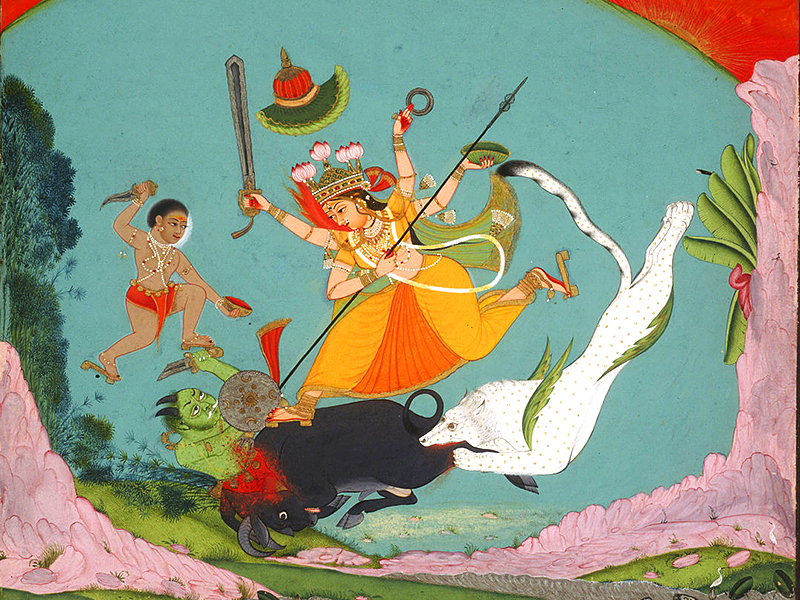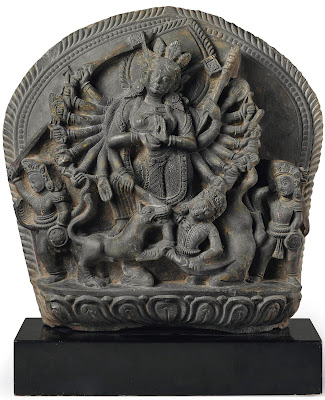Saturday, September 03, 2022 -  Antiquities Trafficking Unit - ATU,art restitution,Durga,Homeland Security Investigations,Manhattan District Attorney,Nepal
Antiquities Trafficking Unit - ATU,art restitution,Durga,Homeland Security Investigations,Manhattan District Attorney,Nepal
 No comments
No comments
 Antiquities Trafficking Unit - ATU,art restitution,Durga,Homeland Security Investigations,Manhattan District Attorney,Nepal
Antiquities Trafficking Unit - ATU,art restitution,Durga,Homeland Security Investigations,Manhattan District Attorney,Nepal
 No comments
No comments
Restitution: A timeline of one black stone stela of Durga
The Supreme shakti, Maa Durga, an incarnation of Goddess Parvati, the daughter of Himavan, the lord of the mountains. She is the mother-goddess -- Shakti -- the power that runs the universe and is worshiped with utmost devotion in Hindu religion. According to legend, Durga was created for the slaying of the demon Mahisasura by Brahma, Vishnu, Shiva, and the lesser gods, who were otherwise powerless to overcome him. Embodying their collective energy (shakti), she is both derivative from the male divinities and the manifested representation of their power and fought Mahishasura over a period of fifteen days during which he kept changing his shape to become different animals and misled her.
She is perhaps the most important goddess of the Hindus, often depicted triumphantly as the destroyer of evil – with her ten mighty arms carrying lethal weapons. Through all her forms, she encompasses the essence of salvation and sacrifice so it is fitting to try and outline here the passage of one venerated sculpture that has recently gone home thanks to the work of the New York District Attorney's Office in Manhattan and their Antiquities trafficking unit.
On/around 1960s
A 14th century black stone stela of Durga, an object of reverence and worship, venerated in a shrine in the Kathmandu Valley in Nepal is stolen.
Here is a simplified overview of her journey following her plunder in Nepal, through the hands of corrupt dealers and a very wealthy collector in the United States. The hard and attentive work of law enforcement agents, public prosecutors, trafficking analysts and anti-trafficking advocates combined successfully brought this endangered cultural and religious sculpture back home to the people of Nepal.
Established Chronology
After its theft in the 1960s and by 1969
The 14th century black stone stele of Durga from Nepal surfaces in New York with numerous Nepali statues handled by "dealer and trafficker Doris Wiener during the 1960s" before being sold to Asian art collector and longtime partner at Wall Street investment house of Lehman Brothers, Paul E. Manheim, who in turn donates and loans many artworks to the Hofstra University Museum of Art in Hempstead, New York in Long Island.
For two decades Manheim was a fundamental contributors and advisors of loans and donations to various other museums including the Brooklyn Museum, the Fralin Museum of Art at the University of Virginia, the Hood Museum, the Los Angeles County Museum of Art, the Museum of Fine Arts Boston, the Smithsonian, and the Snite Museum of Art at the University of Notre Dame. He also advised Robert Lehman on his own multi-million dollar collection which is now at the Metropolitan Museum of Art.
20-21 September 1985
Sotheby's hosts its "Indian, Tibetan, Nepalese, Thai, Khmer and Javanese Art, Including Indian Miniatures"sale in New York.
A rather hefty with 710 lots, the property included pieces with Paul Manheim, Robert Ellsworth, George Bickford, the Hagop Kevorkian Fund, and the late Mr. Robert Payne. 50 sculptures were consigned by Paul E. Manheim.
16 September 2009
Christie's New York offers over 200 selected works in the sale of Indian and Southeast Asian Art, including exceptional bronzes, stone sculptures and Indian miniatures. This auction too includes a selection from the collection of Mr. and Mrs. Paul E. Manheim, as well as various other private collections.
13 September 2011
NB: A similar 15th century black stone stele of Durga from Nepal is consigned to Christie's in New York for its upcoming 13 September 2011 Indian & Southeast Asian Art Auction and is assigned Lot 345.
The listing states that the artefact was on loan to the Hofstra University Museum of Art, New York since 1969 and lists its provenance as:
Collection of Mr. and Mrs. Paul E. Manheim, New York, on loan to Hofstra University Museum of Art, New York, since 1969
The artwork sells for USD 6,250.
12 September 2012
The 14th century black stone stele of Durga from Nepal is consigned to Christie's in New York for its upcoming 12 September 2012 Indian & Southeast Asian Art Auction and is assigned Lot 543.
The listing states that the artefact was once on loan to the Hofstra University Museum of Art, New York from 1969-2010.
Its provenance, like with the September 2011sale, is listed as:
Collection of Mr. and Mrs. Paul E. Manheim, before 1969.
The artwork sells for USD 16,250.
23 March 2022
The 14th century black stone stele of Durga from Nepal is scheduled for auction at Christie's for a third time, listed as coming from a distinguished Chicago collection and estimated to sell for 12,000 - 18,000 USD. The stela is withdrawn in advance of the sale.
6 June 2022
Based on an investigation conducted by Assistant District Attorney Bradley Barbour, Investigative Analyst Daniel Healey, Hilary Chassé, and Apsara Iyer; and Special Agent Igor Gamza of Homeland Security Investigations, under the supervision of Assistant District Attorney Matthew Bogdanos, Chief of the Antiquities Trafficking Unit and Senior Trial Counsel, with investigative support by Dr. Erin Thompson, the black stone stele of Durga from Nepal is formally seized. Its seizure was made possible by the evidence from the Manhattan Office’s investigation into Nancy Weiner, the daughter of Doris Weiner, who was convicted in September 2021 for her role in trafficking and selling millions of dollars’ worth of stolen antiquities in New York County.
24 August 2022
The New York District Attorney's Office in Manhattan returns of the 14th century black stone stele of Durga to the people of Nepal. In a formal handover ceremony held at the Manhattan District Attorney's office, acting Consul General Vishnu Gautam received the black stone stele of Durga from Nepal from Manhattan District Attorney Alvin L. Bragg Jr.
The repatriation ceremony was also attended by agents from U.S. Homeland Security Investigations (“HSI”) New York, including Acting Deputy Special Agent in Charge Mike Alfonso as well as analysts from the DANY- Manhattan Antiquities trafficking Unit.
In closing, and as ARCA has said (repeatedly) in the past, buying and selling ancient art requires a prudent purchaser, one willing to research the provenience (country of origin) and provenance (history of ownership) of an object they intend to own, and to evaluate the available information in the context of the current legal framework.
When details of an object's past are omitted, by the seller, by an antiquities dealer or by an auction house, either intentionally or accidentally, and/or when a buyer knowingly turns a blind eye, each are complicit in facilitating the illicit market and the destruction of cultural heritage. In the 21st century churning trafficked antiquities through the legitimate marketplaces, buying, selling, and donating, intentionally mislabeled pretty things while still conveniently clinging to the negligent “don’t ask, don’t tell” approach is inexcusable.





0 comments:
Post a Comment